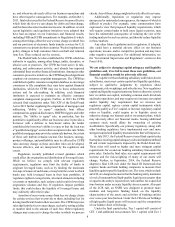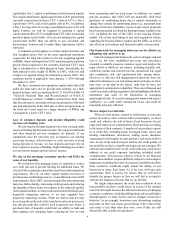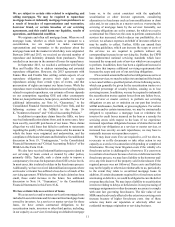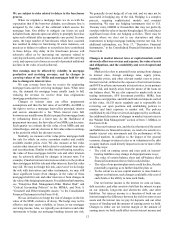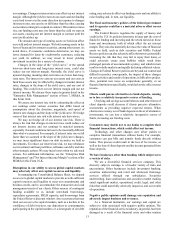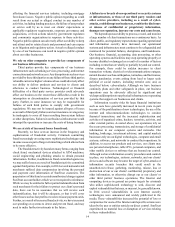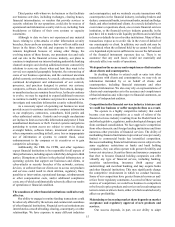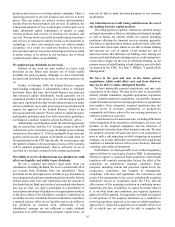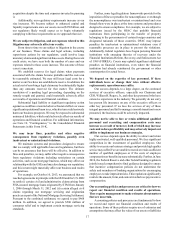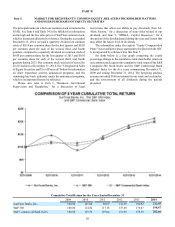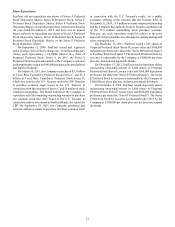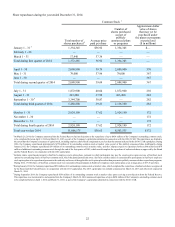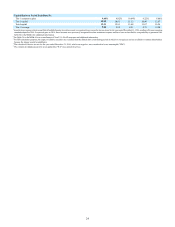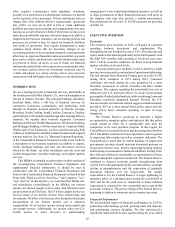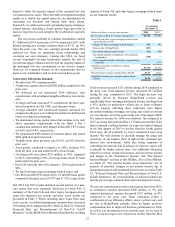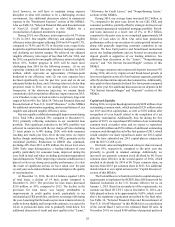SunTrust 2014 Annual Report Download - page 41
Download and view the complete annual report
Please find page 41 of the 2014 SunTrust annual report below. You can navigate through the pages in the report by either clicking on the pages listed below, or by using the keyword search tool below to find specific information within the annual report.18
and financial results. Several of our accounting policies are
critical because they require management to make difficult,
subjective, and complex judgments about matters that are
inherently uncertain and because it is likely that materially
different amounts would be reported under different conditions
or using different assumptions. Pursuant to U.S. GAAP, we are
required to make certain assumptions and estimates in preparing
our financial statements, including in determining credit loss
reserves, reserves related to litigation and the fair value of certain
assets and liabilities, including the value of goodwill, among
other items. If assumptions or estimates underlying our financial
statements are incorrect, or are adjusted periodically, we may
experience material losses.
Management has identified certain accounting policies as
being critical because they require management's judgment to
ascertain the valuations of assets, liabilities, commitments, and
contingencies. A variety of factors could affect the ultimate
value that is obtained either when earning income, recognizing
an expense, recovering an asset, valuing an asset or liability, or
recognizing or reducing a liability. We have established detailed
policies and control procedures that are intended to ensure these
critical accounting estimates and judgments are well controlled
and applied consistently. In addition, the policies and procedures
are intended to ensure that the process for changing
methodologies occurs in an appropriate manner. Because of the
uncertainty surrounding our judgments and the estimates
pertaining to these matters, we cannot guarantee that we will
not be required to adjust accounting policies or restate prior
period financial statements. We discuss these topics in greater
detail in Item 7, MD&A, "Critical Accounting Policies,” Note
1, “Significant Accounting Policies,” and Note 18, "Fair Value
Election and Measurement," to the Consolidated Financial
Statements in this Form 10-K.
Further, from time to time, the FASB and SEC change the
financial accounting and reporting standards that govern the
preparation of our financial statements. In addition, accounting
standard setters and those who interpret the accounting
standards (such as the FASB, SEC, banking regulators and our
outside auditors) may change or even reverse their previous
interpretations or positions on how these standards should be
applied. Changes in financial accounting and reporting
standards and changes in current interpretations may be beyond
our control, can be hard to predict and could materially affect
how we report our financial results and condition. In some cases,
we could be required to apply a new or revised standard
retroactively, resulting in us restating prior period financial
statements.
Our financial instruments carried at fair value expose us to
certain market risks.
We maintain at fair value a securities AFS portfolio and
trading assets and liabilities and derivatives, which include
various types of instruments and maturities. Additionally, we
elected to record selected fixed-rate debt, mortgage loans, MSRs
and other financial instruments at fair value. Changes in fair
value of the financial instruments carried at fair value are
recognized in earnings. The financial instruments carried at fair
value are exposed to market risks related to changes in interest
rates, market liquidity, and our market-based credit spreads, as
well as to the risk of default by specific borrowers. We manage
the market risks associated with these instruments through
active hedging arrangements or broader ALM strategies.
Changes in the market values of these financial instruments
could have a material adverse impact on our financial condition
or results of operations. We may classify additional financial
assets or financial liabilities at fair value in the future. See Note
18, “Fair Value Election and Measurement" in this Form 10-K.
Our controls and procedures may not prevent or detect all
errors or acts of fraud.
Our controls and procedures are designed to provide
reasonable assurance that information required to be disclosed
by us in reports we file or submit under the Exchange Act is
accurately accumulated and communicated to management, and
recorded, processed, summarized, and reported within the time
periods specified in the SEC's rules and forms. We believe that
any disclosure controls and procedures or internal controls and
procedures, no matter how well conceived and operated, can
provide only reasonable, not absolute, assurance that the
objectives of the control system are met.
These inherent limitations include the realities that
judgments in decision making can be faulty, that alternative
reasoned judgments can be drawn, or that breakdowns can occur
because of a simple error or mistake. Additionally, controls can
be circumvented by the individual acts of some persons, by
collusion of two or more people or by an unauthorized override
of the controls. Accordingly, because of the inherent limitations
in our control system, misstatements due to error or fraud may
occur and not be detected, which could result in a material
weakness in our internal controls over financial reporting and
the restatement of previously filed financial statements.
Our stock price can be volatile.
Our stock price can fluctuate widely in response to a variety
of factors including:
• variations in our quarterly results;
• changes in market valuations of companies in the
financial services industry;
• governmental and regulatory legislation or actions;
• issuances of shares of common stock or other securities
in the future;
• changes in dividends;
• the addition or departure of key personnel;
• cyclical fluctuations;
• changes in financial estimates or recommendations by
securities analysts regarding us or shares of our common
stock;
• announcements by us or our competitors of new services
or technology, acquisitions, or joint ventures; and
• activity by short sellers and changing government
restrictions on such activity.
General market fluctuations, industry factors, and general
economic and political conditions and events, such as terrorist
attacks, economic slowdowns or recessions, interest rate
changes, credit loss trends, or currency fluctuations, also could
cause our stock price to decrease regardless of operating results.
For the above and other reasons, the market price of our


